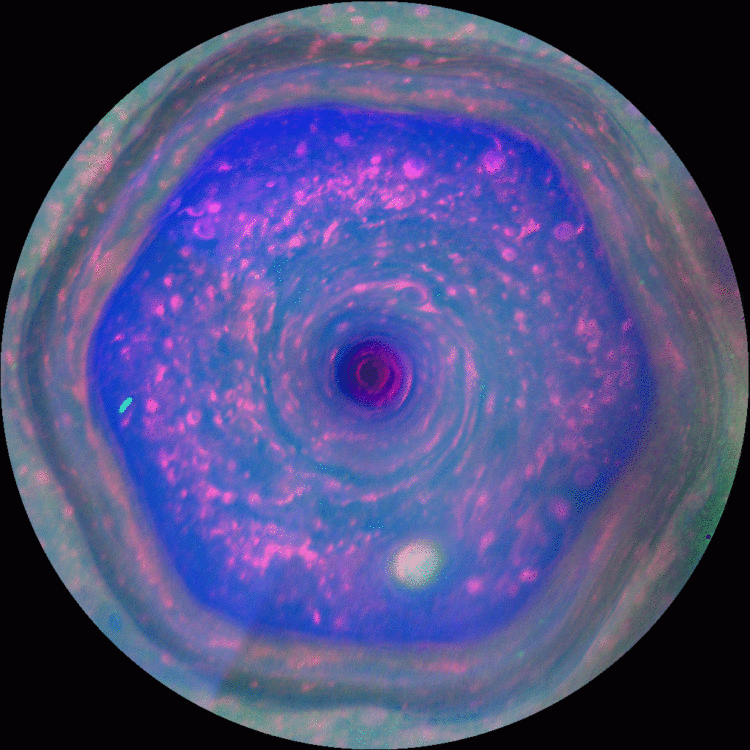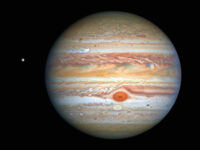With a radius of over nine and a half times that of Earth’s and an atmosphere consisting of almost entirely hydrogen and helium, Saturn is a gas giant. But most notoriously, Saturn is known for the beautiful rings of ice and rock particles that orbit around its equator.
However, lesser known to most is its vibrant hexagon-shaped north pole. The first glimpse at this phenomenon was when the Voyager spacecraft flew by in 1980. It was not until 2012 during the Cassini mission that a motion picture was taken. With greater detail, scientists were able to observe a hurricane with an eye centered at the most northern point, which was estimated to be over 50 times wider than any storm seen on Earth. Countless smaller vortices ranging in all sizes surround the massive polar vortex. Some of these current patterns were observed getting caught up in the hexagonal jet stream while others simply spun in place. Although beautiful and magnificent to look at, scientists are still puzzled by it today: Why do they observe this hexagonal pattern on a spherical planet surrounded by elliptical rings?
Scientists were able to observe a hurricane with an eye centered at the most northern point, which was estimated to be over 50 times wider than any storm seen on Earth.
As described by Andrew Ingersoll, one of the Cassini imaging team members, “the hexagon is just a current of air, and weather features out there that share similarities to [Earth] are notoriously turbulent and unstable.” Despite the similarity to current patterns seen on Earth, the chaotic, unstable air flow is unfamiliar and bizarre to many scientists. Although there have been some previous investigations in understanding how the current patterns cause the hexagonal pole, a 2020 study by two scientists from Harvard University’s Department of Earth and Planetary Sciences took a deeper look into the physics of this pattern using computer simulation models.
Previously, the hexagonal hurricane was believed to exist mostly along the surface, only extending about 100 kilometers down into the atmosphere. However, the two Harvard scientists suggested that the hexagon most likely pierces thousands of kilometers deep. They concluded this after the computer simulation showed deep thermal convection was the most likely explanation for the hexagonal jet stream. Thermal convection is simply the exchange of heat through the movement of liquids or gasses, so in the case of Saturn’s atmosphere, this process occurs at such a rapid and large scale that giant vortices and a powerful jet stream form.
From the simulation, using the measurements taken during the Cassini mission, they discovered that at lower altitudes chaotic circular jets dominate, but as altitude increases, high-speed vortices begin to form at increasing speeds. The stable and chaotic streamlines depend on the radius and proximity to the northern pole. They interact to form the sustained central vortex and, also likely, the six hidden vortices that exist along each of the six points of the hexagon shape.
Despite the similarity to current patterns seen on Earth, the chaotic, unstable air flow is unfamiliar and bizarre to many scientists.
Unintuitively, there is no hexagonal shape on the south pole of Saturn. The simulation was thus also performed on the south pole, which revealed slight differences that caused an offset to disrupt the formation of the hexagon. The central polar cyclone is shifted slightly away from the southernmost point and is sandwiched between two anticyclones, which occur when winds rotate around a center of high pressure. This in turn also results in jet streams that disrupt the formation of any polygonal edges.
With this computer analysis and new understanding for this head-scratching phenomenon, there is still room for improvement. The simulation is not perfect; they were only able to recreate a nine-sided polygon but were still able to provide a scientific proof of concept for how the storm is formed and sustained. With another mission and more data, the two scientists hope to improve their calculations and almost precisely model the hexagonal top.
Proceedings of the National Academy of Sciences (2020). DOI: 10.1073/pnas.2000317117




